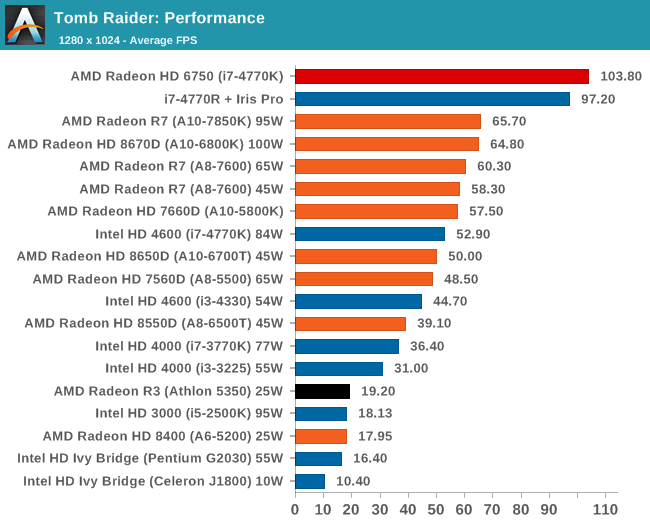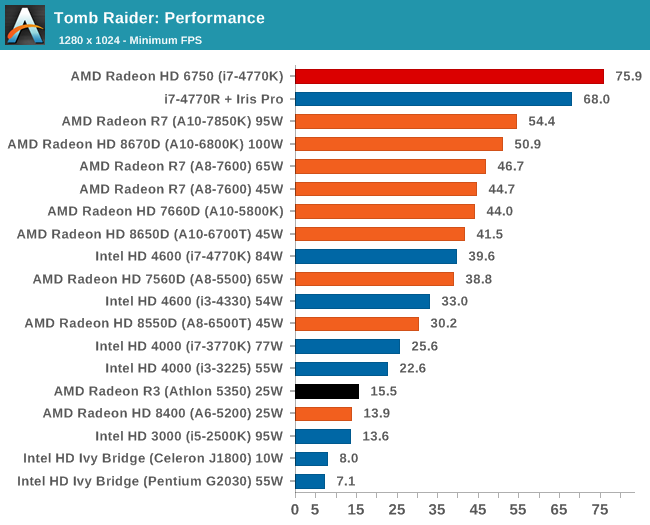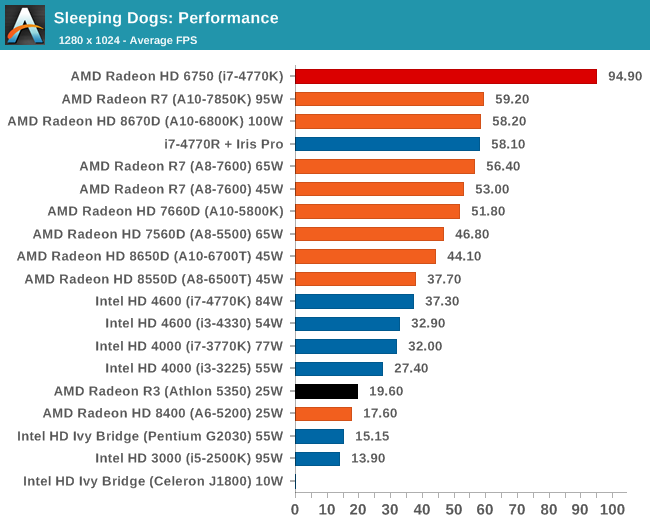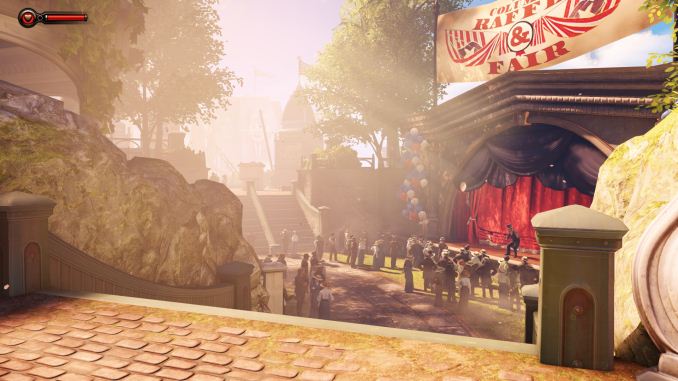The Desktop Kabini Review Part 1: AMD Athlon 5350 (AM1) Tested
by Ian Cutress on April 9, 2014 8:00 AM ESTIGP Gaming
Bioshock Infinite
Bioshock Infinite was Zero Punctuation’s Game of the Year for 2013, uses the Unreal Engine 3, and is designed to scale with both cores and graphical prowess. We test the benchmark using the Adrenaline benchmark tool and the Xtreme (1920x1080, Maximum) performance setting, noting down the average frame rates and the minimum frame rates.


Tomb Raider
The next benchmark in our test is Tomb Raider. Tomb Raider is an AMD optimized game, lauded for its use of TressFX creating dynamic hair to increase the immersion in game. Tomb Raider uses a modified version of the Crystal Engine, and enjoys raw horsepower. We test the benchmark using the Adrenaline benchmark tool and the Perfomance, Quality and Xtreme performance settings, noting down the average frame rates and the minimum frame rates.


Sleeping Dogs
Sleeping Dogs has a highly complex benchmark that can bring the toughest setup and high resolutions down into single figures. Having an extreme SSAO setting can do that, but at the right settings Sleeping Dogs is highly playable and enjoyable. We run the basic benchmark program laid out in the Adrenaline benchmark tool, and the Xtreme (1920x1080, Maximum) performance setting, noting down the average frame rates and the minimum frame rates.















126 Comments
View All Comments
MikeMurphy - Wednesday, April 9, 2014 - link
I'm excited to see this in an upgradeable NUC form factor.jardows2 - Wednesday, April 9, 2014 - link
Please, someone make a thin-mITX for this platform. This is going to be a limited use platform anyway, so there is no reason to put in the full gamut of I/O on the back.jabber - Wednesday, April 9, 2014 - link
Mmm vertically stacked and the size of a paperback book.But whats this...they put the VGA socket at the top! Noooooooooo!
No analogue audio out on the back, just at the front! Noooooooooo!
Yep seen that.
macs - Wednesday, April 9, 2014 - link
Sorry Anandtech but this is not a good review.Where is power consumption data? Comparison with Intel Haswell G1820 (really affordable Haswell chip)? Htpc quality? Older generation (amd e-350)??
Communism - Wednesday, April 9, 2014 - link
They put the newfangled AMD part in the best possible light since they can't afford AMD to be mad at them since AMD pays the bills :PDoes make the a mockery of this Article that it doesn't even include the Intel Haswell G1820 that is it's real competition.
MSRP Intel Haswell G1820 is 42 USD
You can get an H81 board for 49 USD
You can also have real upgradability, since you can go up to a 4670 if you want to.
CiccioB - Wednesday, April 9, 2014 - link
I agree, having a sponsored section on the site isn't really a best thing to avoid any suspicion about bias or favouritism. Any glitch in a review can be seen as a favour to the sponsor. And none will ever know if that's true or not.BTW, I have an Atom D510 (dual physical cores with HT) ITX server which is on 24/24 7/7 used for P2P, backup and some script, stotage and database server. No GFX capacity needed (it is connected to the main PC through Remote Desktop thus "sharing" one of the monitors).
What would be the best solution to replace it if it will eventually die tomorrow?
That Pentium J1800@10W seems very good. Is there something better than that? Consider that power consumption and related fan noise are critical, being always on in my bedroom.
macs - Wednesday, April 9, 2014 - link
I have a similar setup with an AMD e350 itx board. I'm trying to understand if I should upgrade to a newer platform but this review didn't help.Main concern is power consumption, it would be interesting comparing Kabini, BayTrail D and low end Haswell
Communism - Wednesday, April 9, 2014 - link
I can understand not doing the Power Consumption tests, since their standard benching platforms are "Enthusiast" and "Overclocking" motherboards, resulting in higher power consumption of the boards masking the true TDP of the CPU/GPU as a result of the additional chips on the board adding other functionality.They would have to use very sparse basic boards to make the comparison anywhere close to realistic.
jospoortvliet - Thursday, April 10, 2014 - link
Reviews on other sites show AMD consistently beating baytrail at virtually the same active power envelope and much lower idle. Baytrail offers no advantage whatsoever so you can cross that off the list already 😎Beany2013 - Wednesday, April 9, 2014 - link
Try reading the article rather than just looking at the pretty pictures:"As mentioned in our test setup, the benchmark results in this preliminary article are only a small fraction of our normal coverage. Due to other commitments we were unable to run every test on all comparison systems, but we have the other Athlon and Sempron APUs as well as comparable Intel counterparts coming in for review."
Also, the title - Review *Part 1*.
More numbers, compared to competing parts from intel, will be upcoming. It says it in the article - at least twice. It's not ATs problem if you weren't gifted with the good grace to actually read an article before accusing the author of being a shill/being biased/being on the payroll.
Steven R